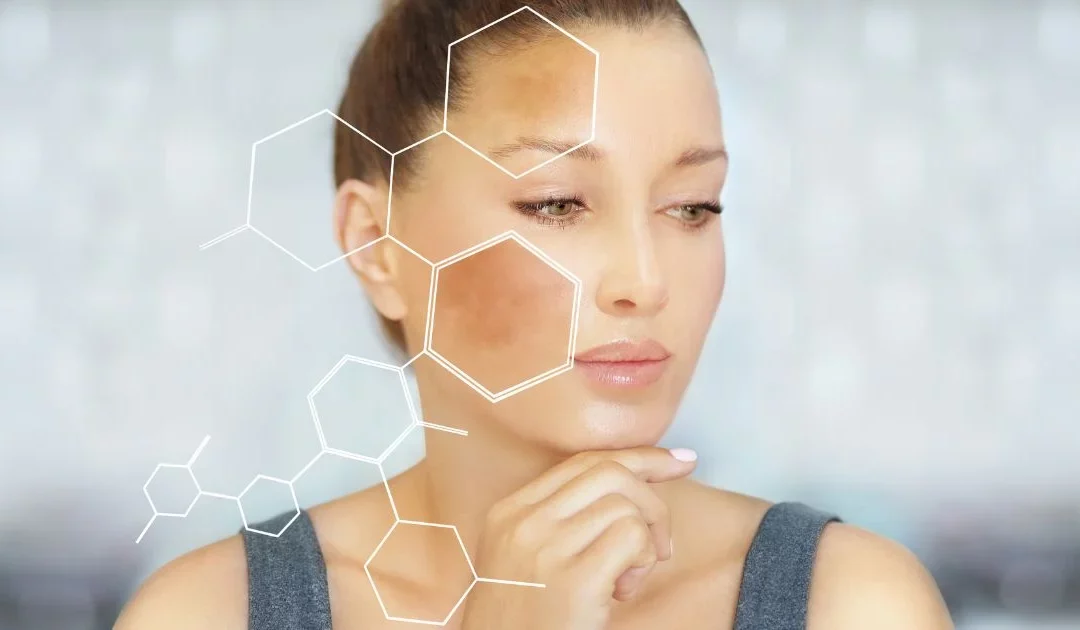Hyperpigmentation is a skin condition that affects millions, often leading to decreased self-esteem and confidence. In our quest for clear and even-toned skin, chemical peels have emerged as a beacon of hope.
This post delves into how these skin rejuvenation treatments, particularly medium or deep chemical peels, can be a game-changer in the fight against hyperpigmentation.
The Science of Hyperpigmentation
Hyperpigmentation is a common skin concern where patches of skin become darker than the surrounding area. This darkening occurs when an excess of melanin, the brown pigment that produces normal skin color, forms deposits in the skin. Understanding the science behind it is crucial for effective treatment and management:
Common Causes
The causes of hyperpigmentation are multifaceted and can range from sun exposure to hormonal changes and skin injuries.
- Sun Exposure: Prolonged exposure to the sun’s UV rays stimulates melanin production as a protective response, often leading to sunspots or solar lentigines.
- Hormonal Influences: Hormonal changes, particularly in women, can cause melasma, resulting in brown or gray-brown patches, typically on the face.
- Skin Inflammation: Post-inflammatory hyperpigmentation occurs when a skin injury or trauma heals and leaves a flat area of discoloration behind.
- Genetic Factors: Some people are more prone to hyperpigmentation due to their genetic makeup.
Types of Hyperpigmentation
Hyperpigmentation can manifest in various forms, each with its unique characteristics.
- Melasma: Usually appears as brown or gray-brown patches on the face, often related to hormonal changes, like pregnancy or birth control pills.
- Sunspots (Age Spots): These are common in areas exposed to the sun, like hands and face, and are usually small, darkened patches.
- Post-Inflammatory Hyperpigmentation: This type follows an injury to the skin, such as cuts, burns, acne, or certain skin-care treatments.
Understanding these aspects of hyperpigmentation is the first step toward effective treatment. It underscores the need for a personalized approach to skincare, particularly when considering treatments like chemical peels.
Chemical Peel Benefits in Skin Rejuvenation
Chemical peels have been a cornerstone of aesthetic dermatology for decades, providing a solution for various skin concerns, from wrinkles to hyperpigmentation. Here’s a deeper dive into how they work and their benefits:
Process
Chemical peels involve applying a specially formulated chemical solution to the skin. This solution works to exfoliate the skin by breaking down the bonds between the cells on the outermost layer of the skin.
Over a few days, this top layer of skin peels off, revealing a new layer of healthier, smoother, and more evenly pigmented skin underneath.
Types of Peels
Chemical peels come in three main types – light, medium, and deep peels.
- Light Peels: These peels only remove the epidermis (the outermost layer of the skin). They’re ideal for treating fine lines, acne, uneven skin tone, and dryness.
- Medium Peels: These penetrate the dermis (the middle layer of the skin) and are more effective against pronounced hyperpigmentation, wrinkles, and sun damage.
- Deep Peels: These reach even further into the dermis and can treat deeper wrinkles, scars, and significant sun damage. However, deep peels have longer recovery times and higher risks, so they’re not suitable for everyone.
Benefits
Chemical peels are a transformative skin care treatment offering a wide array of benefits. Here’s a closer look at how they work to rejuvenate and enhance skin health:
Skin Rejuvenation
- Remove Damaged Skin: The primary action of a chemical peel is to remove damaged outer layers of the skin. This exfoliation process is key to revealing fresh, new skin beneath.
- Reduce Lines and Wrinkles: By eliminating these top layers, chemical peels effectively minimize the appearance of lines and wrinkles, contributing to a smoother, more youthful complexion.
Hyperpigmentation Treatment

- Targeting Deeper Skin Layers: Medium and deep chemical peels are especially adept at addressingfsa pronounced hyperpigmentation. They penetrate deeper into the skin to reach the areas where excess melanin has accumulated.
- Evens Out Skin Tone: This deeper penetration allows for a more effective reduction in dark spots and uneven skin tones, leading to a more balanced and radiant complexion.
Improved Skin Texture
- Smoothing Rough Texture: The process of removing the top layer of skin doesn’t just aid in reducing hyperpigmentation and wrinkles; it also plays a significant role in smoothing out the skin’s texture.
- Softer, Refined Appearance: Post-treatment, the skin often feels softer and more refined, with a visibly enhanced, smoother texture.
Incorporating these key aspects, chemical peels stand out as a powerful tool for comprehensive skin care, addressing issues from hyperpigmentation and wrinkles to overall skin texture and health.
Safety
When performed by a qualified skincare professional, chemical peels are generally safe. However, like any procedure, they do carry some risks, such as redness, scarring, and changes in skin color. Therefore, it’s crucial to have a thorough consultation with a professional who can assess your skin type and condition and guide you to the most suitable type of peel.
Specialized Treatments for Hyperpigmentation
Hyperpigmentation, as we’ve discussed, can take many forms and have various causes. Consequently, its treatment often requires a multifaceted approach.
Among the numerous treatments available, some stand out for their targeted approach to hyperpigmentation. Three such treatments are the Cosmelan Peel, VI Precision Plus, and Sciton Moxi Laser.
Cosmelan Peel
This professional-grade Cosmelan Peel is designed to target and reduce the appearance of hyperpigmentation, while also working to remove damaged skin and diminish lines and wrinkles.
The peel works by inhibiting the process that causes skin discoloration. Active ingredients in the Cosmelan Peel include azelaic acid, kojic acid, and arbutin, all known for their ability to reduce melanin production in the skin.
This peel is often used to treat melasma but is also effective for other types of hyperpigmentation. The Cosmelan Peel is suitable for various skin types and can be used safely on darker skin tones.
VI Precision Plus
This is a powerful, medical-grade chemical peel designed to treat hyperpigmentation and skin damage. The peel contains a synergistic blend of powerful ingredients that work to reduce the appearance of age spots, sun spots, and acne scars.
The VI Precision Plus Peel is unique in that it combines the power of acids and vitamins to provide a comprehensive treatment that not only targets hyperpigmentation but also promotes overall skin health.
Sciton Moxi Laser
The Sciton Moxi Laser is a versatile laser treatment specifically geared to treat deep hyperpigmentation on all skin types. Its non-ablative wavelength technology targets skin cells, promoting healing and collagen production, helping to reduce signs of aging.
It’s safe for all skin types, including darker tones, which is a key advantage, especially in reducing risks associated with post-inflammatory hyperpigmentation. This makes the Moxi Laser a valuable tool for individuals seeking to improve their skin’s health and appearance without the risk of additional pigmentation problems.
Furthermore, the Moxi Laser’s compatibility with other treatments like the BBL HERO enhances its effectiveness. This combination offers a comprehensive skin rejuvenation approach, tackling various skin concerns in a single treatment. The procedure is quick, customizable, and ensures minimal downtime for patients.
All of the treatments mentioned, when performed by trained professionals, can offer significant improvements in skin tone and texture. They help reduce the appearance of dark spots and even out skin tone.
It’s worth noting, however, that everyone’s skin is different. What works well for one person might not work as well for another. Therefore, it’s always recommended to consult with a dermatologist or skincare professional to determine the best course of treatment for your specific needs.
Post-Treatment Care and Considerations
Post-treatment, the skin becomes temporarily more sensitive to the sun, making sun protection crucial. Consulting with a skincare professional is essential before undergoing any chemical peel treatment.
These peels offer a non-surgical solution to many skin concerns, making them an attractive option for those looking to rejuvenate their skin without invasive procedures.
Conclusion
Chemical peels, especially medium and deep peels, are a potent tool in the fight against hyperpigmentation. They offer a path to rejuvenated, more youthful-looking skin. For those considering this treatment, it’s vital to seek professional advice to ensure it’s tailored to your specific skin needs.
Remember, individual results may vary, and adequate sun protection post-treatment is a must.
Unlock Radiant Skin with Expert Care: Schedule Your Consultation at Applied Aesthetic
Are you ready to take the next step towards achieving a brighter, more even-toned complexion? At Applied Aesthetic, we’re committed to helping you realize your skin rejuvenation goals. Join us in exploring transformative treatments tailored to your unique needs under the expert guidance of Natalie Sharp, FNP-BC, our skilled and compassionate practitioner.
Don’t let hyperpigmentation hold you back any longer. Discover how treatments like the Cosmelan Peel can revolutionize your skincare regimen.
Schedule a consultation with Natalie Sharp, FNP-BC, today and embark on your journey to radiant, rejuvenated skin. Your path to confidence and clarity starts with us at Applied Aesthetic.





